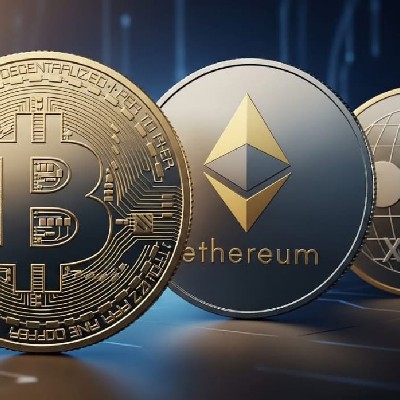
ARPA priceARPA
ARPA/USD price calculator
ARPA market Info
Live ARPA price today in USD
Do you think the price of ARPA will rise or fall today?
Now that you know the price of ARPA today, here's what else you can explore:
How to buy ARPA (ARPA)?How to sell ARPA (ARPA)?What is ARPA (ARPA)What would have happened if you had bought ARPA (ARPA)?What is the ARPA (ARPA) price prediction for this year, 2030, and 2050?Where can I download ARPA (ARPA) historical price data?What are the prices of similar cryptocurrencies today?Want to get cryptocurrencies instantly?
Buy cryptocurrencies directly with a credit card.Trade various cryptocurrencies on the spot platform for arbitrage.ARPA price prediction
When is a good time to buy ARPA? Should I buy or sell ARPA now?
What will the price of ARPA be in 2026?
In 2026, based on a +5% annual growth rate forecast, the price of ARPA(ARPA) is expected to reach $0.01336; based on the predicted price for this year, the cumulative return on investment of investing and holding ARPA until the end of 2026 will reach +5%. For more details, check out the ARPA price predictions for 2025, 2026, 2030-2050.What will the price of ARPA be in 2030?
About ARPA (ARPA)
What Is ARPA?
ARPA is a blockchain-based secure computation network known for its privacy-preserving capabilities and efficient data sharing. Originally named ARPA Chain, it rebranded into ARPA Network in October 2022. This network is built on Ethereum and operates as a Layer 2 solution, enhancing the Ethereum blockchain's scalability and efficiency. ARPA's primary focus is on secure multi-party computation (MPC), allowing multiple parties to collaborate on computations while keeping their data inputs private. This unique feature positions ARPA as a pivotal player in various sectors, including finance, healthcare, and data management.
The network's rebranding to ARPA Network signifies a shift in focus from general-purpose MPC to Threshold BLS Signature Schemes (TSS-BLS), a subset of MPC. This transition aims to push the boundaries of blockchain technology, enabling a wider range of use cases. ARPA's decentralized nature and advanced cryptographic algorithms offer a secure and scalable infrastructure for applications requiring privacy and data integrity. These include applications in decentralized finance (DeFi), insurance, artificial intelligence (AI), and more, making ARPA a versatile and powerful tool in the blockchain ecosystem.
Resources
Official Documents: https://docs.arpanetwork.io/
Official Website: https://www.arpanetwork.io/
How Does ARPA Work?
ARPA employs advanced cryptographic techniques to enable private computation and data sharing without revealing the underlying data. This is achieved through its secure multi-party computation (SMPC) framework, which ensures data privacy and security while maintaining high scalability. The network's design prevents nodes from accessing secure data they are not authorized to, enhancing overall network security and scalability. Additionally, ARPA's use of sharding techniques in its infrastructure further boosts its scalability, allowing for more efficient transaction processing.
The network's shift to TSS-BLS has introduced a unique grouping mechanism, enabling multiple groups of nodes to participate in BLS signature tasks simultaneously. This significantly increases throughput and efficiency. ARPA's support for multiple blockchains allows developers to customize their signature policy according to different security levels required by various applications. The decentralized nature of ARPA not only strengthens physical tamper protection but also disperses risk by eliminating single points of failure. This makes ARPA an ideal platform for applications requiring high levels of security and privacy, such as secure wallets, cross-chain bridges, and decentralized custody.
What Is ARPA Token?
ARPA is the native currency of the ARPA Network. It plays a crucial role in maintaining the network's ecosystem, facilitating secure and efficient computation, and data storage. The token is used for various purposes within the ARPA ecosystem, including paying for data and computation, serving as a security deposit for computation tasks, and participating in community governance. Token holders can use ARPA tokens to vote on network proposals, influencing the future direction of the network. ARPA has a maximum supply of 2 billion tokens, with a distribution that includes rewards, team allocation, foundation reserves, and sales.
What Determines ARPA's Price?
The price of ARPA, like any cryptocurrency, is primarily influenced by market supply and demand dynamics, a fundamental principle that drives the valuation of digital assets in the blockchain ecosystem. Demand for ARPA tokens is closely tied to the perceived utility and potential of the ARPA Network. As a blockchain-based secure computation network that facilitates privacy-preserving smart contracts and data sharing, ARPA's appeal to investors and users in the decentralized finance (DeFi), data security, and blockchain privacy sectors significantly impacts its demand. The more adoption and use cases the ARPA Network finds in these burgeoning sectors, the higher the potential demand for its tokens, which can positively affect its price.
Another crucial factor influencing ARPA's price is the network's technological advancements and partnerships. Developments such as the transition from general-purpose Multi-Party Computation (MPC) to Threshold BLS Signature Schemes (TSS-BLS) and the network's ability to support multiple blockchains enhance its attractiveness. These technological strides not only demonstrate ARPA's commitment to innovation but also its adaptability to the evolving needs of the blockchain community. Additionally, strategic partnerships and collaborations with other blockchain projects, financial institutions, and tech companies can lead to increased visibility and credibility, further driving demand for ARPA tokens. Market sentiment, often swayed by news, updates, and community engagement, also plays a significant role in shaping the price of ARPA tokens.
Furthermore, the overall market conditions of the cryptocurrency sector significantly impact ARPA's price. In a bullish market, where investor confidence is high, cryptocurrencies, including ARPA, tend to see an increase in value. Conversely, in bearish conditions, the price may face downward pressure. Regulatory news, global economic factors, and technological breakthroughs in the broader blockchain and cryptocurrency industries can also indirectly influence ARPA's valuation. As the blockchain space continues to mature, ARPA's integration of cutting-edge privacy and computation solutions positions it as a potentially valuable asset in the diverse and rapidly evolving world of digital currencies.
For those interested in investing or trading ARPA, one might wonder: Where to buy ARPA? You can purchase ARPA on leading exchanges, such as Bitget, which offers a secure and user-friendly platform for cryptocurrency enthusiasts.
Bitget Insights



ARPA/USD price calculator
ARPA resources
Tags:
What can you do with cryptos like ARPA (ARPA)?
Deposit easily and withdraw quicklyBuy to grow, sell to profitTrade spot for arbitrageTrade futures for high risk and high returnEarn passive income with stable interest ratesTransfer assets with your Web3 walletWhat is ARPA and how does ARPA work?
Global ARPA prices
Buy more
FAQ
What is the current price of ARPA?
What is the 24 hour trading volume of ARPA?
What is the all-time high of ARPA?
Can I buy ARPA on Bitget?
Can I get a steady income from investing in ARPA?
Where can I buy ARPA with the lowest fee?
Related cryptocurrency prices
Prices of newly listed coins on Bitget
Hot promotions
Where can I buy ARPA (ARPA)?
Video section — quick verification, quick trading









